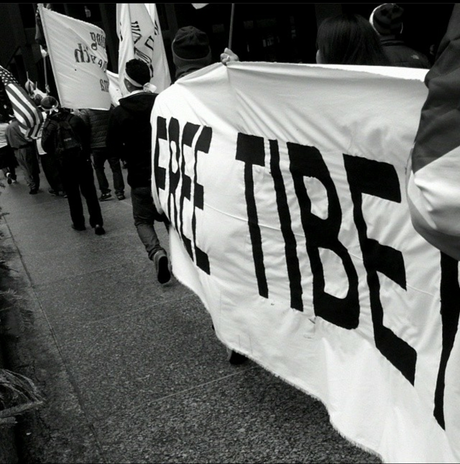I have a story to tell you.
It is one that is not particularly new to the world, in its concept or inception, but is one that has been incessantly censored from reaching the rest of society.
This is about a silent genocide that has spanned over 71 years, leaving thousands of people decimated yet continues to this day.
This is the story of my people.
Tibet is located in South Asia, bordered by countries such as India, Nepal, Pakistan, Bhutan and China. It is often referred to as the “Roof of the World” due to its glorious elevation and the presence of Mt. Everest, the tallest mountain in the world that is part of the country’s Himalayan mountain range.
These very mountains in Tibet are what form the Yangtze, Yarlung Tsangpo, Yellow, Indus, Mekong, Ganges and Salween Rivers. These rivers are responsible for supplying water to approximately 85% of the population in Asia, which constitutes about 47% of the world’s population. In addition, Tibet has a large abundance of natural resources such as gold, silver, and copper, as well as oil.
But the presence of such resources has historically made Tibet a target to other countries whose aim is to economically profit through exploiting them.
Our story begins in 1949, the year in which the Chinese Communist Revolution transpired, resulting in Mao Zedong being declared the new leader of the People’s Republic of China. Subsequently, in 1950, Zedong commanded the Chinese military to invade Tibet, ultimately ensuing in China seizing full control of the country.
Due to Tibet’s strong link with Buddhism, which encourages nonviolence, the country did not have a substantial army, rendering it an easy success for the Chinese military.
Soon after, Zedong proposed a treaty called the 17-Point Agreement in 1951. This agreement declared that China would have sovereignty over Tibet but assured that the Chinese government would not modify Tibet’s political system nor force Tibetans to make any changes in their way of life.
The 14th Dalai Lama, Tenzin Gyatso, Tibet’s spiritual leader who was also acting as the political leader of the country during this time, signed the agreement. He was given no other choice but to do so because even as a 16-year-old at the time, he knew the harm and destruction that would be inflicted on his people if he rejected it. This “agreement” proved to be completely fraudulent—For the next eight years, slowly but surely, China began to establish its unrelenting control and power over Tibet.
Then came March 10, 1959. Mao Zedong was in Lhasa, the capital of Tibet, visiting a Chinese military camp. He sent an invitation to the Dalai Lama requesting his presence at a ballet performance that was being held at the military camp.
Over ten thousand Tibetans took to the streets of Lhasa and surrounded the Potala Palace, where the Dalai Lama resided, to prevent him from leaving. People were fearful that this invitation was a deceptive disguise for an assassination attempt. Here, people began protesting against China’s invasion and occupation in an effort to regain Tibetan independence.
Unfortunately, the Chinese military arrived heavily armored and caused mass destruction, leaving many thousands of people dead. The Dalai Lama was exiled and thus, forced to flee with thousands of other Tibetans across the Himalayas and into India for safety. Today, the Dalai Lama still resides in Dharamsala, India, where the Tibetan government-in-exile has also been established.
Since 1959, the Tibetan diaspora has significantly grown as a result of thousands of people fleeing Tibet to find refuge in other countries around the world.
The Dalai Lama, now 85 years old, has given teachings worldwide to encourage people to treat all living beings with kindness and compassion, while also exposing the atrocious human rights violations and genocide that has been occurring in Tibet.
The Chinese government continues to insist that Tibetans are living safely and joyfully with their own autonomy—this is far from the truth.
Not only are Tibetans living outside the country barred from ever entering Tibet, but journalists, tourists and diplomats are not allowed to visit either to witness the true state of Tibetans residing under Chinese rule.
Celebrities who show their support for the Free Tibet movement or the Dalai Lama, including Lady Gaga most recently, have not only been banned from China but their content is also censored from being seen by the Chinese public. This alone says a thousand words.
The reality of Chinese occupation is that thousands of monasteries and temples, which are holy places of worship for Tibetans, have been destroyed, some of which are over hundreds of years old.
Thousands of Tibetan monks and nuns have been captured, tortured, raped and either kept as political prisoners or brutally murdered.
Any Tibetans who are found with Buddhist scriptures, religious idols or even a portrait of the Dalai Lama in their homes suffer the same vicious and cruel consequences.
The Tibetan language is not allowed to be spoken anymore, so children are being forced to learn Mandarin Chinese in schools.
And Tibetans who are discovered uttering even one negative word about Xi Jinping (the new leader of China), the Chinese government or simply voicing their disapproval of China’s rule over Tibet disappears along with their entire family. No trace of their existence being left behind. This is evidence that the Chinese government’s ultimate goal is to eradicate Tibetans, our culture and our religion.
Those still living in Tibet remain resilient, emphasizing that they will not tolerate the control and oppression being enforced by China.
This genocide has been ruthlessly censored by the Chinese government, which is why it is never in mainstream media and continues to be ignored by international organizations like the United Nations, despite Tibetans’ many pleas for the past 70 years.
Because the Buddhist faith teaches Tibetans to remain nonviolent, instead of harming others, there have been Tibetans who have resorted to self-immolation. Self-immolation is the act of setting oneself on fire as a form of protest and has been used by others for religious and historical contexts for centuries. It is estimated that over 155 Tibetans have self-immolated since 1959. These individuals have been children, as young as the age of 14 years old, as well as mothers, fathers, monks and nuns. This has been done out of desperation to raise awareness and in the hopes that it will finally attract global attention towards these appalling human rights violations that are being committed by the Chinese government.

This genocide is the very reason why many Tibetans, including myself, cannot trace our ancestry past our grandparents. People like my grandparents had to leave their whole lives and even families behind as small children in order to survive another day.
March 10, 2021, marks the 62nd anniversary of the National Uprising Day that occurred in 1959.
Countless Tibetans sacrificed their lives, praying that our people would soon be free again. Every year on this very day, Tibetans and our allies around the world honor and pay tribute to these martyrs by participating in peaceful protests around the world. These protests, known as the “Free Tibet” movement, are meant to spread the word about the genocide and oppression that is still occurring to Tibetans to this day.
But it is also our way of sending a message to the Chinese government—as long as there are Tibetans living in this world, we will remain resilient and dedicate our lives to fighting for our people and for our freedom every single day.
If you would like to be an ally to Tibetans, please do your own research, reach out to your U.S. senators and representatives and encourage them to speak up about the human rights violations and genocide that is occurring in Tibet. Support organizations like Students for a Free Tibet that devote each and every day to this cause.
Because I am privileged to be the first-generation college-educated individual of my family and to have been born and raised in a country where people are empowered to speak out against human rights violations. I have always felt that it is my duty to educate as many people as I can for the sake of the many Tibetans who remain voiceless from China’s persistent censorship.
I am proud to be Tibetan because it has come with resilience and eternal strength that has been woven into my soul.
One World, One Dream. FREE TIBET.



